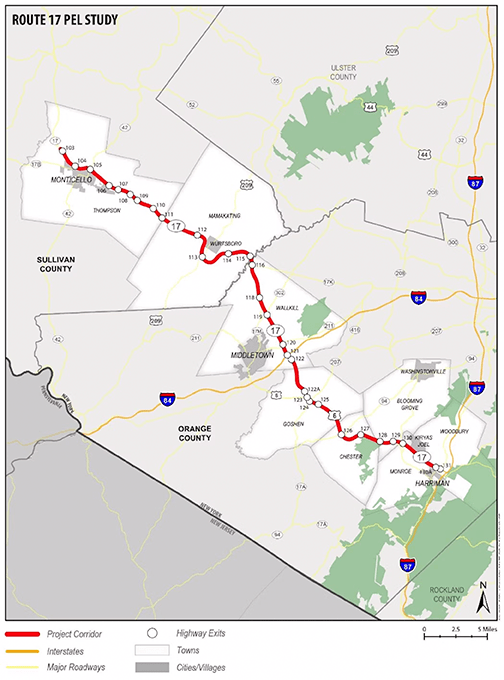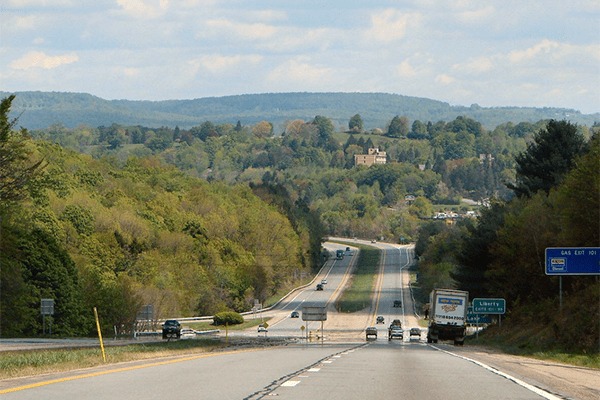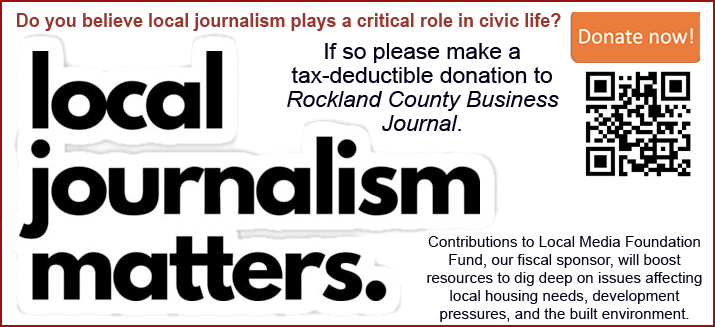|
RCBJ-Audible (Listen For Free)
|
Economic Development Organizations and Public Officials Support Conversion; Environmental Groups and Regional Plan Association Voice Opposition; Potential Adverse Impact To Rockland Not Considered
ANALYSIS
In 2006, when plans were revealed to construct five Las Vegas-style casinos in the Catskills, United States Senator Chuck Schumer pushed for the widening of Route 17 through Orange and Sullivan Counties. The casino plans never materialized, but the dream for some of expanding Route 17 into six-lane Interstate 86 — which has been bandied about for decades — never died.
Groups like 17-Forward-86, a coalition of more than 200 local businesses and trade groups, have mobilized support for the project, saying the two-lane highway, originally built to take congestion off local roads, limits population growth and stifles economic development. Maureen Halahan, the president and CEO of the Orange County Partnership, a business development group, is a co-founder of 17-Forward-86.
17-Forward-86 was established in August 2018 by leaders of economic development, construction, environmental stewardship, tourism, business, health care, and energy companies who support the expansion of Route 17. The coalition shares a vision of expanding the capacity of Route 17 to strengthen the economic well-being of the Hudson Valley and Sullivan Catskills, which includes Rockland County because it is a conduit between Manhattan and the rest of the Hudson Valley.
Governor Kathy Hochul supports the plan, which is in the early stages of the environmental review process. Hochul has committed a total of $1 billion for the conversion of Route 17 to I-86 and is focused on completing the environmental studies necessary before shovels can hit the road.
The state plans to move forward with a General Use Third Lane, a project would cost anywhere from $650 million to $1.27 billion to complete, and would benefit from federal funding options.

Support also comes from New York State Senator James Skoufis who says, “For too long, local and regional travelers have heard empty promises about the future of Route 17 to I-86 conversion, and we have all seen those rusty ‘Future I-86’ signs along the shoulder to prove it. I have fought long and hard for almost a decade to advance this stalled infrastructure project, and I am thrilled to see our continued advocacy paying off. When completed, this interstate will serve as a vital connector and tourism corridor for the Hudson Valley and the Catskills, buoying our economy with new jobs and easier access to the exceptional amenities this region is known for.”
A coalition which includes Bethel Woods Center for the Arts, Hudson Valley Pattern for Progress, Hudson Valley Economic Development Corporation, Orange County Chamber of Commerce, and Legoland— also support expansion because they believe it will spur economic development, aid in the transport of goods and services, and improve Route 17’s safety.
The proposed expansion being studied includes a 47-mile stretch between Exit 103 (Rapp Road) in Sullivan County and Exit 131 (I-87 – Harriman) in Orange County, including reconstruction or reconfiguration of every exit ramp along the corridor. The first phase would involve a 30-mile stretch from Exit 131 in Harriman to Exit 113 (Route 209) near Wurtsboro in Sullivan County.
The corridor provides access to area attractions like Legoland, Bethel Woods Center for the Arts, and Woodbury Commons Premium Outlets.
Impact On Rockland County
Drivers along the I87/I287 corridor in Rockland County, heading westbound on weekday afternoon rush-hours and especially on Fridays when residents of New York City and Westchester clog the roads to escape north to the Catskills, know Rockland’s roads cannot handle additional traffic. Expansion of the Route 17 corridor and the anticipated economic growth that expansion would bring to Orange and Sullivan Counties would add additional cars and trucks to Rockland’s highways (including cars on the Palisades Parkway which connects to Route 17).
The study undertaken by the DOT does not address the possible adverse impacts Rockland residents would suffer from increased economic development to the north.
Rockland has already become a development target for warehouses and distribution and fulfillment centers, with each project adding incremental truck traffic to Rockland’s already overused roads.
The Planning and Environmental Linkage Study
A Planning and Environmental Linkage (PEL) Study prepared for New York State Department of Transportation has considered alternatives to expansion, including light rail and rapid bus transit, but rejected those options in favor of widening the road to a third lane of general use traffic in each direction. The DOT found the population along the Route 17 corridor inadequate to support either light rail or rapid bus transit.
Widening may be a misnomer, as Route 17 was constructed with room in the median for expansion. The road itself may cover more ground, but additional lands may not need to be taken along the corridor to complete the project.
Not everyone is on board with the expansion. The Catskill Mountainkeeper, a nonprofit whose mission is to protect the region’s natural resources, opposes expansion, arguing that expanding the highway will lead to more cars and increased pollution.
It points to “induced demand” – a concept akin to a self-fulfilling prophecy, that widened roadways do nothing to ease traffic, it simply leads to greater usage and additional traffic.
Catskill Mountainkeeper is also concerned with the project’s environmental impact. With more traffic lanes and more cars, millions of tons of carbon dioxide emissions could be released, according to the group. The group says the DOT should evaluate the project’s impact in accordance with the state’s Climate Leadership and Community Project Act.
The Regional Plan Association Report
New York’s Regional Plan Association (RPA), an independent non-profit civic organization that develops and promotes ideas to improve the economic health, environmental resiliency, and quality of life of the New York metropolitan area, released a report last week titled “Evaluating the Route 17 Highway Widening Project.”
Its authors question whether there are actual benefits to the highway expansion project, saying “Research makes it clear that highway widenings do not necessarily solve congestion and other transportation problems, in fact, widenings frequently exacerbate the very problems they seek to address and many times create additional problems for highway users and the people living along the corridor.”
According to the RPA report, “Congestion is documented as an issue on occasional summer evenings for drivers heading westbound and some Sunday afternoons for those heading eastbound. Although congestion is documented to occur only about 2 percent of the time and generally only around specific intersections, some area citizens are calling for a wider road along the entire corridor length.”
Highway Widening and Induced Demand
According to the RPA, it is well documented that highway widening creates more congestion. Here’s why:
- When traffic is known to move slowly, people plan trips more carefully. If they can, they travel at times when there is less congestion, to less congested locations or use non-car modes of transportation.
- When there are multiple travel options, people will choose the one that best suits them –the decision of how, where, and when to travel is based on the cost, time commitment, and comfort of the choices.
- By widening a congested road, travel times are initially reduced. Thus, the choice to use that road at that time is made more attractive. People who had traveled at other times (non-peak), who had used other modes (transit), or gone to other places or by other routes now use the newly widened road. They quickly use up the newly created capacity. This is referred to as “induced demand.”
There are two forces of induced demand – short-term or latent and long-term induced demand. Latent demand is the portion of traffic that would use the road today if the trip were faster. The increase in supply (road capacity) allows for more users at once.
Long-term induced demand is the portion of traffic that is drawn to the area. The increase in supply (road capacity) drives down the [time] cost of the trip, bringing new users into the market and feeds the vicious cycle of creating more car dependence, which feeds demand for more auto infrastructure, which ultimately results in more auto dependence.
The authors say, “Induced demand also has negative impacts on local communities by moving congestion from the segment widened to other locations, typically to local residential and main streets where traffic is ultimately destined.”
The RPA also points out that the project undermines the state’s environmental goals and is inconsistent with a variety of plans, including the landmark Climate Leadership and Community Protection Act of 2019, which commits the state to 100 percent zero-emission electricity by 2040, sets legally binding emissions reduction standards to get New York completely off of fossil fuels by 2050, and mandates that 40% of state climate and energy funding be invested in disproportionately disadvantaged communities.
The Natural Resources Defense Council has also weighed in in opposition, saying: “Expanding Route 17 is not only at odds with the state’s climate law but would be inconsistent with other state laws and federal transportation requirements. Indeed, since the Route 17 expansion would rely on federal monies and approvals, the proposed project would also run afoul of several national, climate-related transportation policies.”
Featured image by: Wikimedia Commons
















